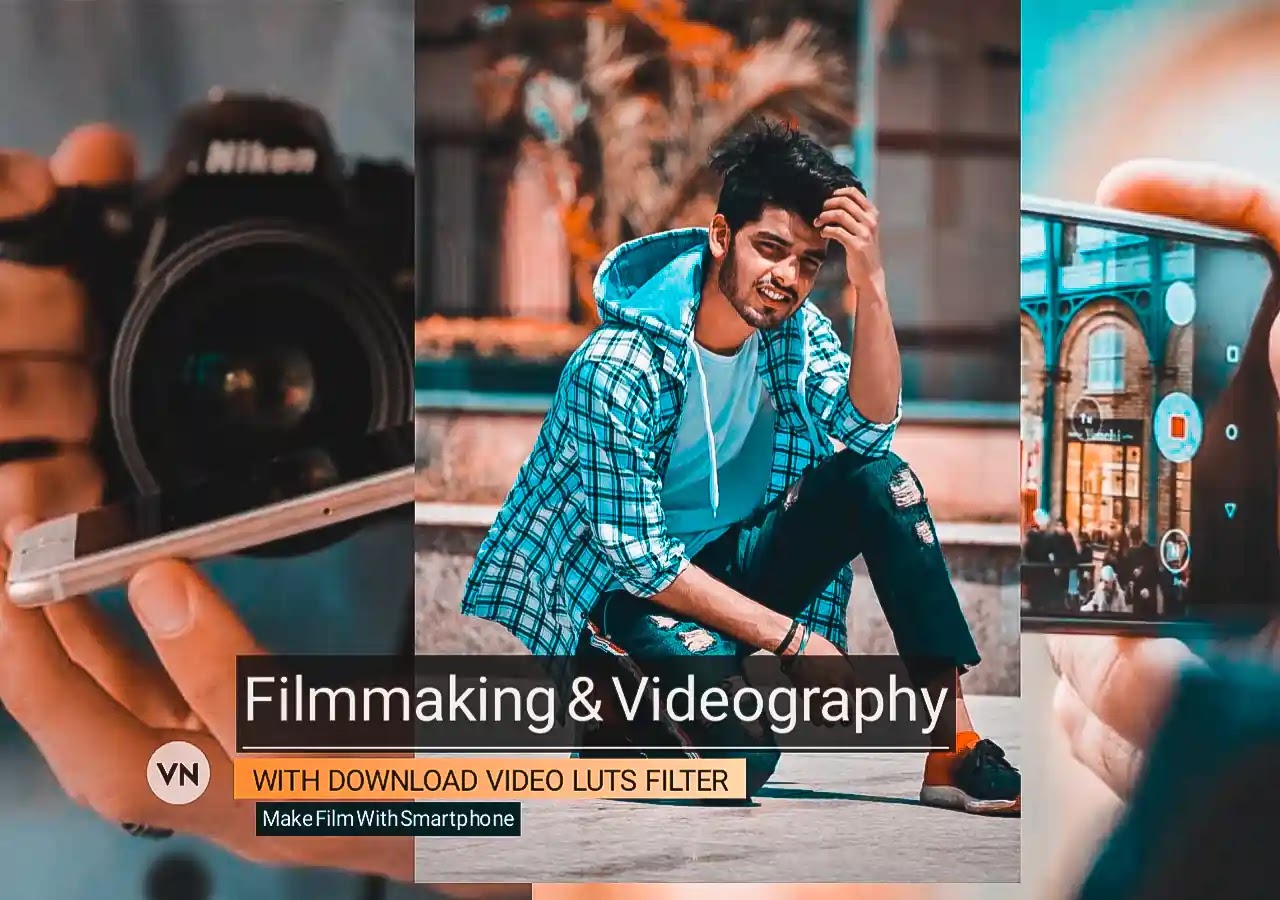Filmmaking and videography from mobile is easy, but it is important to use the right technology.
In today's post, we are going to give you information about film making and videography. How film making and videography can be done using a smartphone, so if you also want to shoot a good video from your smartphone, then this post will be very useful for you.
(Toc)
 |
| Filmmaking & Videography |
👇
Tips: How to filmmaking And Video recoding with smartphone
Filmmaking and videography are no longer the exclusive domain of expensive cameras and professional equipment. With the advancements in technology, smartphones have become powerful tools for capturing high-quality videos and creating professional-looking films.
Here are some tips on how to make the most of your smartphone for filmmaking and videography:
1. Invest in a stabilizer
One of the biggest challenges of filming with a smartphone is keeping the footage steady. A stabilizer can help keep your phone steady while you film, resulting in smoother and more professional-looking footage. There are several types of stabilizers available, including gimbal stabilizers, tripod mounts, and even handheld stabilizers.
2. Use a tripod
Another way to keep your footage steady is by using a tripod. A tripod will help keep your phone in a fixed position, preventing camera shake and allowing you to focus on your composition and framing.
3. Use a microphone
The built-in microphone on your smartphone may not always produce the best audio quality. To improve the audio for your film or video, consider investing in an external microphone. There are several types of external microphones available, including lavalier microphones, shotgun microphones, and handheld microphones.
4. Experiment with different angles and perspectives
One of the benefits of using a smartphone for filming is that it is small and portable, making it easy to experiment with different angles and perspectives. Try filming from different heights, angles, and distances to add visual interest to your footage.
5. Edit your footage
Once you've captured your footage, it's important to edit it to make it look polished and professional. There are several video editing apps available for smartphones, including iMovie, Adobe Premiere Rush, and Kinemaster. These apps allow you to trim, cut, and adjust your footage, as well as add music, text, and special effects.
How To record quality Video in smartphone For Filmmaking
To record high-quality video on a smartphone, follow these tips:
- Make sure your phone's camera lens is clean before recording.
- Use the highest resolution and frame rate settings available on your phone's camera app.
- Use the rear-facing camera, as it typically has a higher resolution than the front-facing camera.
- Hold your phone steady while recording. Use a tripod or a stabilizer if possible.
- Use good lighting. Natural light is best, but if you're indoors, try to position yourself near a window or use a light source.
- Use the focus and exposure controls to adjust the video to your liking.
- If possible, use an external microphone to improve audio quality.
- Consider editing the video after recording. There are many free and inexpensive video editing apps available.
- Lastly, try to avoid zooming while recording as it will decrease the overall quality of the video.
Filmmaking Editing technique in smartphone
Filmmaking has come a long way since the early days of cinema. With the advent of smartphones and their ever-evolving technology, it's now easier than ever for anyone to make a film. One of the most important aspects of filmmaking is editing. It's the process of selecting and arranging footage to create a cohesive and compelling story. The editing process can be time-consuming and requires a certain level of skill, but with the right editing technique, it can be done on a smartphone.
Choose The Right Editing App:-
The first step in editing on a smartphone is to choose the right editing app. There are many different apps available, each with its own set of features and capabilities. Some popular options include iMovie, Adobe Premiere Rush, and LumaFusion. Each app has its own unique set of tools and features, so it's important to find one that fits your needs and skill level.
Organizing And Cut Your Footage:-
Once you've chosen an editing app, it's time to start organizing your footage. This can be done by creating a rough cut of your film, which is a rough version of the final film that includes all the footage you plan to use. This will help you see the overall structure of your film and make decisions about what footage to keep and what to discard.
Start Fine-Tuning The Editing
Once you have a rough cut of your film, it's time to start fine-tuning the editing. This is where you'll add transitions, adjust the timing of shots, and make sure the pacing of the film is just right. It's also important to pay attention to the audio in your film, as this can greatly impact the overall feeling of the film.
Keep The Editing Simple And Focus On The Story You're Trying To Tell
One of the most important things to keep in mind when editing on a smartphone is to keep it simple. It's easy to get carried away with all the different tools and features available, but it's important to remember that less is often more. Keep the editing simple and focus on the story you're trying to tell.
Filmmaking & Videography Filter: To Colour Grade Film footage
Color grade plays a huge role in filmmaking and videography, whereby video footage is color graded depending on the situation. So filmmakers use many techniques to color grade a video, but the best way is to apply video filters. So here are some filters to color grade movie videos.
In conclusion, editing on a smartphone is a great way to make a film, but it requires a certain level of skill and patience. By choosing the right editing app, organizing your footage, and keeping it simple, you can create a compelling and cohesive film that tells a great story. With the advancement of smartphone technology, it has become easier to make and edit a film, and the possibilities are endless. So, next time you're thinking of making a film, don't let the lack of equipment hold you back. Use your smartphone as your editing tool and start creating today!
Top 5 Best smartphone for Video Recording & Filmmaking
In today's world, smartphones have become an essential tool for capturing and recording videos. With the advancements in technology, the cameras on smartphones have become incredibly sophisticated and can produce high-quality videos. For those who are into video recording and filmmaking, having a smartphone with a good camera is crucial. Here is a list of the top 5 best smartphones for video recording and filmmaking.
iPhone 11 Pro: Apple's iPhone 11 Pro is a top-of-the-line smartphone that is perfect for video recording and filmmaking. It features a triple-camera system with a 12MP wide, ultra-wide, and telephoto lens. The camera also has 4K video recording at 60fps and can shoot in slow motion at 1080p at 240fps. With its advanced image stabilization, the iPhone 11 Pro is a great option for capturing smooth and stable videos.
Samsung Galaxy S20 Ultra: The Samsung Galaxy S20 Ultra is another great smartphone for video recording and filmmaking. It features a 108MP camera that can shoot in 8K video resolution. The camera also has a 100x hybrid zoom, which is great for capturing distant shots. The camera also has a night mode for capturing stunning low-light videos.
Google Pixel 4: The Google Pixel 4 is another great option for video recording and filmmaking. It features a 12.2MP camera that can shoot in 4K resolution at 30fps. The camera also has a night sight mode that allows you to capture stunning low-light videos. The camera also has a motion mode that captures motion in a still photo.
Huawei P40 Pro: The Huawei P40 Pro is a great option for video recording and filmmaking. It features a quad-camera system with a 50MP main camera, 40MP ultra-wide camera, 12MP telephoto camera, and a 3D depth sensor. The camera can shoot in 4K resolution at 60fps and has a night mode for capturing stunning low-light videos.
OnePlus 8 Pro: The OnePlus 8 Pro is another great smartphone for video recording and filmmaking. It features a triple-camera system with a 48MP main camera, 48MP ultra-wide camera, and 8MP telephoto camera. The camera can shoot in 4K resolution at 60fps and has a night mode for capturing stunning low-light videos.
Conclusion
In conclusion, smartphones have become powerful tools for filmmaking and videography. With the right equipment and techniques, you can create professional-looking films and videos using just your smartphone. Remember to invest in a stabilizer, use a tripod, use an external microphone, experiment with different angles and perspectives, and edit your footage to make it look polished and professional.






Hardik
ReplyDeletePppppp
ReplyDelete